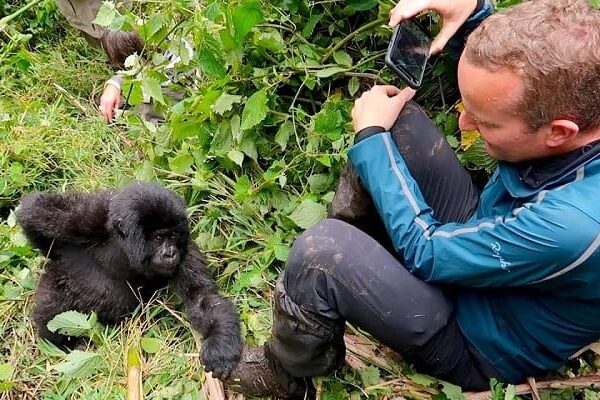Primate Tracking in Semuliki National Park. Into the Realm of the Forest Dwellers
At the heart of Uganda’s western frontier, nestled between the Rwenzori Mountains and the Congo Basin lowlands, lies a world where time seems untouched by modern rhythms—Semuliki National Park. This is a sanctuary where the whisper of the rainforest, the rush of the Semuliki River, and the distant calls of unseen creatures create an atmosphere unlike any other. Though widely celebrated as Uganda’s birding paradise, Semuliki is equally revered for a different yet equally thrilling adventure—primate tracking.
With over eight primate species inhabiting its dense rainforests, Semuliki offers one of the most immersive encounters with some of humanity’s closest relatives. To walk under the towering canopy, hearing rustles above and catching fleeting glimpses of fur and tails, is to step into a timeless drama of survival, play, and coexistence. Every tracking experience unfolds differently, shaped by the forest’s moods, the animals’ behaviors, and the patience of the tracker.
Primate tracking in Semuliki is not merely an excursion; it is a journey into the heart of Africa’s living heritage, where every encounter tells a story of adaptation, intelligence, and ecological balance.
The Unique Setting of Semuliki for Primate Encounters
A Distinctive Rainforest Environment
Unlike most of Uganda’s protected forests, Semuliki is an extension of the Ituri Rainforest of the Democratic Republic of Congo. This gives it a lowland tropical rainforest ecosystem rarely found elsewhere in East Africa. The park’s altitude, between 670 and 760 meters above sea level, creates a warm, humid climate that supports an array of species more typical of Central Africa than Uganda.
The dense vegetation, interspersed with swampy areas and riverine habitats, provides an ideal home for primates. The tall trees offer fruiting canopies, while the understory shelters insectivorous species. The ecological diversity ensures that primates of different diets and habits thrive within the same environment, making Semuliki a hotspot for tracking opportunities.
A Crossroads of Biodiversity
Semuliki is a biological crossroads, where East and Central African species overlap. This results in a primate community that reflects extraordinary variety. For travelers, this means the chance to encounter not only the familiar faces of Uganda’s monkeys but also species rarely seen in other parks.
The Primates of Semuliki National Park
Olive Baboons
The olive baboon is among the most conspicuous primates in Semuliki. Large troops roam the forest edges and savanna fringes, recognizable by their expressive faces and social dynamics. Observing baboons is always fascinating, as their behavior mirrors complex hierarchies, grooming rituals, and playful antics. Their adaptability allows them to thrive in both open and forested areas, often offering some of the most accessible sightings for trackers.
Red-tailed Monkeys
The red-tailed monkey, with its striking chestnut-red tail and white facial markings, is one of the most elegant species of Semuliki. Agile and arboreal, these monkeys are frequently seen leaping between branches in search of fruits, seeds, and insects. They often form mixed-species troops with other monkeys, enhancing the spectacle for trackers who may encounter multiple species at once.
Black-and-white Colobus Monkeys
The black-and-white colobus is among the most iconic primates of African forests. Their long, flowing white mantles and tails make them visually striking against the green canopy. These leaf-eating specialists are quieter than other monkeys, often resting in groups high in the trees. Tracking them requires patience, but the reward is the chance to watch their graceful movements and social bonds.![]()
Grey-cheeked Mangabeys
The grey-cheeked mangabey is another highlight for trackers. Known for their loud whooping calls, these monkeys are highly active and move in sizable troops. Their playful, curious nature makes them particularly engaging to observe, as they forage for fruits and seeds in the mid-levels of the forest.
De Brazza’s Monkeys
Among the rarer species in Semuliki, the De Brazza’s monkey is distinguished by its white beard and orange crown. Often shy and elusive, they are found near swampy areas and along the river. Their cryptic behavior means that sightings are considered a special reward for trackers who dedicate time to quieter, patient observation.
Vervet Monkeys
The vervet monkey thrives in more open woodland habitats within the park. Their adaptable nature makes them common, but their social interactions and playfulness continue to fascinate trackers. Vervets are excellent indicators of predator presence, often raising alarm calls that ripple across the forest when danger is near.
Pottos
While less conspicuous than diurnal species, the potto adds a nocturnal dimension to primate tracking in Semuliki. These slow-moving, nocturnal primates are often observed during night walks, clinging to branches and hunting insects. Their large eyes and deliberate movements make them particularly memorable for those fortunate enough to encounter them under torchlight.
Chimpanzees of Semuliki
Although not as habituated as in Kibale or Budongo, small populations of chimpanzees inhabit Semuliki. Their presence is often indicated by calls, distant drumming, or nests seen in trees. Spotting chimps in Semuliki is more challenging due to the dense forest, but the possibility adds a layer of excitement to every tracking expedition. For researchers and dedicated trackers, the chance to glimpse these great apes in such a raw, unspoiled environment is profoundly moving.
The Experience of Primate Tracking
Preparation and Guidance
Primate tracking in Semuliki begins with guidance from experienced rangers and local trackers. These individuals, deeply familiar with the forest, interpret subtle signs—fresh droppings, broken branches, distant calls—to lead visitors toward active groups. Their expertise transforms the experience, ensuring that each walk becomes both an educational journey and an adventure.
The Rhythm of the Forest
Tracking primates is as much about embracing the rhythm of the forest as it is about the animals themselves. Mornings often begin with a chorus of calls, signaling the start of activity. As the sun rises, monkeys become more visible, feeding, grooming, and playing. Midday often brings quieter periods, while evenings again resonate with activity as primates settle into resting sites.
The unpredictability of the encounters adds to the allure. A troop may suddenly emerge above a trail, or a baboon group may be found foraging in an open clearing. Patience, attentiveness, and respect for the forest’s pace are essential elements of the experience.
An Immersive Encounter
Unlike safari game drives, primate tracking requires travelers to move on foot, becoming part of the forest. The sounds, smells, and textures of the environment become central to the experience. The rustle of leaves, the scent of damp earth, and the sight of monkeys swinging overhead create an immersion that is both sensory and emotional. Each encounter feels personal, as if stepping briefly into the world of creatures who have thrived here for millennia.
The Role of Primate Tracking in Conservation
Primate tracking in Semuliki carries profound conservation significance. By attracting eco-conscious visitors, the activity generates revenue that supports the protection of the forest and its inhabitants. It also provides employment for local communities, reducing pressures on the forest from unsustainable practices.
Moreover, the presence of tourists underscores the value of primates as living treasures, fostering a culture of conservation among both locals and international visitors. Each successful tracking expedition becomes part of a broader effort to ensure that Semuliki’s primates continue to thrive in their natural habitats.
Cultural Dimensions of Primate Tracking
The human presence in and around Semuliki has shaped the ways primates are understood and encountered. The Batwa pygmies and Bamba people have lived alongside the forest’s primates for generations. Their folklore often intertwines with monkey behavior, offering cultural insights that enrich tracking expeditions.
Local guides sometimes share these stories during tracking experiences, adding layers of meaning to encounters. Observing a troop of colobus monkeys becomes more than a wildlife moment; it becomes an entry point into the cultural narratives that bind people and nature together in this region.
Best Time for Primate Tracking in Semuliki
The dry seasons, from December to February and June to August, provide the most favorable conditions for primate tracking. Trails are drier and easier to navigate, making it possible to reach deep into the forest where primates are most active. Visibility is also improved, with less dense foliage and clearer skies.
During the wet seasons, from March to May and September to November, primate tracking remains rewarding but more challenging. The forest becomes slippery and muddy, requiring greater endurance. Yet, the rains also bring fresh growth, abundant fruiting, and heightened primate activity, making sightings more dynamic and behaviorally rich. For those willing to embrace the challenges, the wet season offers some of the most vibrant tracking experiences.
The Emotional Power of Tracking Primates
Primate tracking is not solely about observation; it is about connection. Watching a mother colobus cradle her infant, hearing the playful calls of red-tailed monkeys, or catching sight of a chimpanzee nest evokes profound reflections on the kinship between humans and these intelligent beings.
The experience often leaves visitors with a renewed sense of respect for the delicate balance of ecosystems and the role primates play in them. It is not unusual for travelers to describe their encounters as transformative, reshaping their understanding of nature and their place within it.
A Journey Beyond the Ordinary
Primate tracking in Semuliki National Park is an adventure that transcends the ordinary boundaries of tourism. It is a journey into the dense, mysterious rainforests of western Uganda, where every step reveals a new secret, every sound carries meaning, and every encounter with a primate deepens the bond between humans and nature.
From the boisterous baboons to the elusive De Brazza’s monkey, from the graceful colobus to the shadowy potto, Semuliki offers an extraordinary theater of life that rewards those who seek patience, respect, and curiosity. More than an activity, primate tracking here is a reminder of Africa’s enduring wilderness, of the resilience of its creatures, and of the responsibility humanity bears to protect them.
For those ready to embark on this remarkable experience, it is recommended to plan with trusted experts who understand the rhythm of Africa’s wild places. For a seamless, insightful, and unforgettable safari in Semuliki and across Uganda, travelers are encouraged to book their journeys with WildHorn Africa, a dedicated partner in unveiling the continent’s treasures.




 WildHorn Africa – Authentic and unforgettable tours across Africa, guided by local experts who know the land, wildlife, and culture best.
WildHorn Africa – Authentic and unforgettable tours across Africa, guided by local experts who know the land, wildlife, and culture best.


